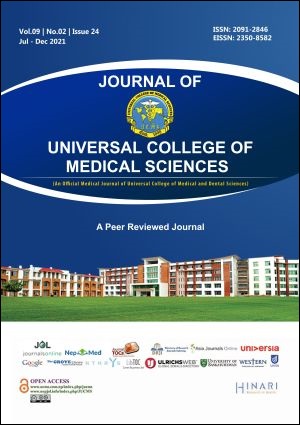Haematological Profile in Microcytic Hypochromic Anaemia in Children
DOI:
https://doi.org/10.3126/jucms.v9i02.41941Keywords:
Microcytic hypochromic anaemia, Iron deficiency anaemia (IDA),, β-Thalassemia, Red cell indicesAbstract
INTRODUCTION: The most common disorders presenting with microcytic hypochromic anaemia are iron deficiency anaemia (IDA) and β-Thalassemia trait (β-TT), and each of them has different pathogenesis and treatment modality. Here we intend to see the haematological profile in microcytic hypochromic anaemia in children apart from IDA and Thalassemia with respect to age and gender.
MATERIAL AND METHODS: A total of 95 pediatric patients between the ages of 2 to 12 years with microcytic hypochromic anaemia were included in the study. Blood samples obtained from each patient were evaluated for various haematological and biochemical profiles along with haemoglobin electrophoresis. It was a hospital based observational cross-sectional study done for a period of 18 months from January 2019 to July 2020.
RESULTS: Severe anaemia was seen in 55 (57.89%) cases, followed by 38 (40.00%) cases with moderate anaemia and 2 (2.11%) cases with mild anaemia. Majority of the cases showed IDA, which were 85 (89.5%) cases, followed by 6 (6.3%) cases with β-TT and 4 (4.2%) cases with β-TM. RBC count, hematocrit and RDW showed significant variation between IDA, β-TM and β-TT. Most number of correctly diagnosed cases were shown by Ricerca Index with 90 (94.74 %).
CONCLUSION: Our study concludes RBC count and RDW, along with Srivasthava Index, Ricerca Index and RDW Index could be used as reliable indices to differentiate between iron deficiency anaemia and β-Thalassemia. Red cell indices, serum iron profile and haemoglobin electrophoresis complement each other for the precise diagnosis of underlying cause of microcytic hypochromic anaemia.
Downloads
Downloads
Published
How to Cite
Issue
Section
License
Copyright (c) 2021 Journal of Universal College of Medical Sciences

This work is licensed under a Creative Commons Attribution-NonCommercial 4.0 International License.
Authors have to give the following undertakings along with their article:
- I/we declare that this article is original and has not been submitted to another journal for publication.
- I/we declare that I/we surrender all the rights to the editor of the journal and if published will be the property of the journal and we will not publish it anywhere else, in full or part, without the permission of the Chief Editor.
- Institutional ethical and research committee clearance certificate from the institution where work/research was done, is required to be submitted.
- Articles in the Journal are Open Access articles published under the Creative Commons CC BY-NC License (https://creativecommons.org/licenses/by-nc/4.0/)
- This license permits use, distribution and reproduction in any medium, provided the original work is properly cited, and it is not used for commercial purposes.




